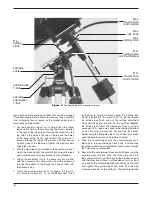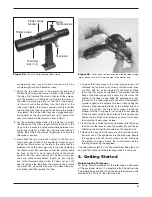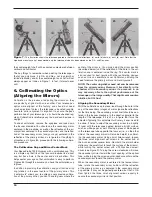
11
If the entire primary mirror reflection is not visible in the sec-
ondary mirror, as in Figure 8c, you will need to adjust the tilt
of the secondary mirror. This is done by alternately loosening
one of the three alignment setscrews while tightening the
other two, as depicted in Figure 10. The goal is to center the
primary mirror reflection in the secondary mirror, as in Figure
8d. Don’t worry that the reflection of the secondary mirror
(the smallest circle, with the collimation cap “dot” in the cen-
ter) is off-center. You will fix that in the next step.
Adjusting the Primary Mirror
The final adjustment is made to the primary mirror. It will
need adjustment if, as in Figure 8d, the secondary mirror
is centered under the focuser and the reflection of the pri-
mary mirror is centered in the secondary mirror, but the small
reflection of the secondary mirror (with your eye inside) is
off-center.
The tilt of the primary is adjusted with the three pairs of colli-
mation screws on the back end of the optical tube (bottom of
the mirror cell, see Figure 11). The collimation screws can be
turned with a Phillips head screwdriver.
Each pair of collimation screws work together to adjust the
tilt. One screw pushes the mirror cell forward, while the other
screw pulls the mirror cell back. One must be loosened and
the other tightened by the same amount in order to adjust the
tilt. Try tightening and loosening one of the pairs of Phillips-
headed collimation screws one turn. Look into the focuser
and see if the secondary mirror reflection has moved closer
to the center of the primary mirror reflection. Repeat this
process on the other two pairs of collimation screws, if nec-
essary. It will take a little trial and error to get a feel for how to
tilt the mirror in this way to center the reflection. Look into the
focuser and see if the secondary reflection has moved closer
to the center of the primary. You can tell this easily with the
collimation cap and mirror center mark by simply watching
Figure 8.
Collimating the optics. (a) When the mirrors are properly aligned, the view down the focuser drawtube should look like this. (b)
With the collimation cap in place, if the optics are out of alignment, the view might look something like this. (c) here, the secondary mirror is
centered under the focuser, but it needs to be adjusted (tilted) so that the entire primary mirror is visible. (d) The secondary mirror is correctly
aligned, but the primary mirror still needs adjustment. When the primary mirror is correctly aligned, the “dot” will be centered, as in (e).
Primary mirror
center mark
Reflective surface
of collimation
cap
drawtube
Reflection
of primary
mirror clip
a.
b.
c.
d.
e.
Figure 9.
To center the
secondary mirror under the
focuser, hold the secondary
mirror holder in place with
one hand while adjusting the
center bolt with a Phillips
screwdriver. Do not touch the
mirror’s surface!
Figure 10.
Adjust the tilt
of the secondary mirror by
loosening or tightening the
three alignment setscrews with
a 2mm allen wrench

































